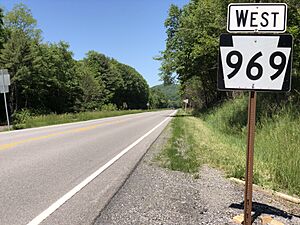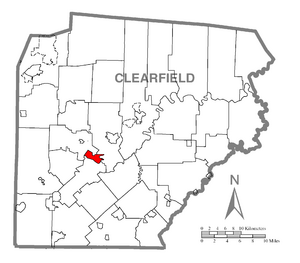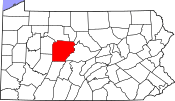Lumber City, Pennsylvania facts for kids
Quick facts for kids
Lumber City, Pennsylvania
|
|
|---|---|
|
former Borough
|
|

PA 969 within the former Lumber City limits
|
|

Location of Lumber City in Clearfield County
|
|

Location of Clearfield County in Pennsylvania
|
|
| Country | United States |
| State | Pennsylvania |
| County | Clearfield |
| Settled | 1835 |
| Incorporated | 1857 |
| Dissolved | 2014 |
| Government | |
| • Type | Borough Council |
| Area | |
| • Total | 2.7 sq mi (7.5 km2) |
| • Land | 2.7 sq mi (7.1 km2) |
| • Water | 0.2 sq mi (0.4 km2) |
| Elevation | 1,220 ft (370 m) |
| Population
(2010)
|
|
| • Total | 76 |
| • Density | 28/sq mi (10.7/km2) |
| Time zone | UTC-5 (Eastern (EST)) |
| • Summer (DST) | UTC-4 (EDT) |
| Area code(s) | 814 |
Lumber City was a small town, or "borough," located in Clearfield County, Pennsylvania, in the United States. In 2010, only 76 people lived there.
Lumber City was officially dissolved as a separate town on January 6, 2014. It then became part of a larger area called Ferguson Township.
Contents
Where Was Lumber City Located?
Lumber City was in the southwestern part of Clearfield County. It was situated on the north side of the West Branch Susquehanna River.
The town was surrounded by other areas. To its north was Penn Township. To its northeast was Pike Township.
Roads and Rivers Near Lumber City
Two main roads passed through or near Lumber City. Pennsylvania Route 969 followed the West Branch Susquehanna River. It led northeast to Curwensville and west to U.S. Route 219.
Pennsylvania Route 729 crossed the West Branch at Lumber City. This road went north to Grampian and south to Glen Hope.
The United States Census Bureau reported that before it merged, Lumber City covered about 7.5 square kilometers (2.9 square miles). Most of this area was land, but about 0.4 square kilometers (0.15 square miles) was water. The upstream part of Curwensville Lake on the West Branch was also located near Lumber City.
How Many People Lived There?
The population of Lumber City changed quite a bit over the years.
| Historical population | |||
|---|---|---|---|
| Census | Pop. | %± | |
| 1860 | 192 | — | |
| 1870 | 230 | 19.8% | |
| 1880 | 298 | 29.6% | |
| 1890 | 266 | −10.7% | |
| 1900 | 224 | −15.8% | |
| 1910 | 363 | 62.1% | |
| 1920 | 383 | 5.5% | |
| 1930 | 264 | −31.1% | |
| 1940 | 300 | 13.6% | |
| 1950 | 262 | −12.7% | |
| 1960 | 164 | −37.4% | |
| 1970 | 57 | −65.2% | |
| 1980 | 117 | 105.3% | |
| 1990 | 83 | −29.1% | |
| 2000 | 86 | 3.6% | |
| 2010 | 76 | −11.6% | |
| 2015 (est.) | 75 | −1.3% | |
| Sources: | |||
In the year 2000, there were 86 people living in Lumber City. These people lived in 34 different homes, and 28 of these were families.
Who Lived in Lumber City?
Most of the people in Lumber City were White. A small number of people were of two or more races. About 1% of the population was Hispanic or Latino.
Many homes (about 35%) had children under 18 living there. Most homes (about 70%) were married couples living together. Some homes (about 15%) had people living alone.
The average age of people in Lumber City in 2000 was 41 years old. About a quarter of the population was under 18. About a third of the population was between 25 and 44 years old. Another third was between 45 and 64 years old. A smaller group (about 8%) was 65 years or older.
See also
 In Spanish: Lumber City (Pensilvania) para niños
In Spanish: Lumber City (Pensilvania) para niños


